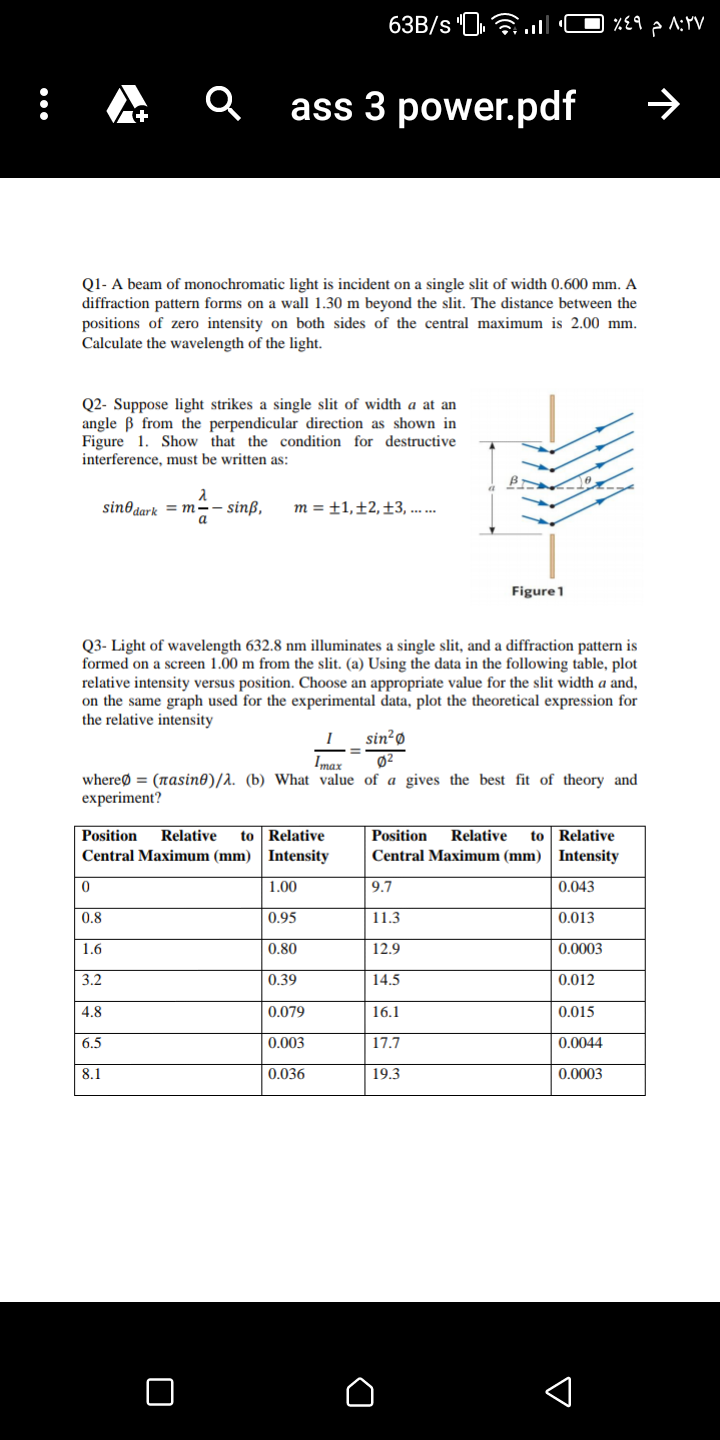63B/s "O a.l ass 3 power.pdf Q1- A beam of monochromatic light is incident on a single slit of width 0.600 mm. A diffraction pattern forms on a wall 1.30 m beyond the slit. The distance between the positions of zero intensity on both sides of the central maximum is 2.00 mm. Calculate the wavelength of the light. Q2- Suppose light strikes a single slit of width a at an angle B from the perpendicular direction as shown in Figure 1. Show that the condition for destructive interference, must be written as: m = ±1,±2,±3, ... .. sin@dark = m- sinß, Figure1 Q3- Light of wavelength 632.8 nm illuminates a single slit, and a diffraction pattern is formed on a screen 1.00 m from the slit. (a) Using the data in the following table, plot relative intensity versus position. Choose an appropriate value for the slit width a and, on the same graph used for the experimental data, plot the theoretical expression for the relative intensity sin²ø Ø2 whereø = (nasin®)/A. (b) What value of a gives the best fit of theory and %3D Imax experiment? to Relative Relative Central Maximum (mm) | Intensity Relative Relative Position Position to Central Maximum (mm) | Intensity 1.00 9.7 0.043 0.8 0.95 11.3 0.013 1.6 0.80 12.9 0.0003 3.2 0.39 14.5 0.012 4.8 0.079 16.1 0.015 6.5 0.003 17.7 0.0044 0.0003 0.036 8.1 19.3 •..
63B/s "O a.l ass 3 power.pdf Q1- A beam of monochromatic light is incident on a single slit of width 0.600 mm. A diffraction pattern forms on a wall 1.30 m beyond the slit. The distance between the positions of zero intensity on both sides of the central maximum is 2.00 mm. Calculate the wavelength of the light. Q2- Suppose light strikes a single slit of width a at an angle B from the perpendicular direction as shown in Figure 1. Show that the condition for destructive interference, must be written as: m = ±1,±2,±3, ... .. sin@dark = m- sinß, Figure1 Q3- Light of wavelength 632.8 nm illuminates a single slit, and a diffraction pattern is formed on a screen 1.00 m from the slit. (a) Using the data in the following table, plot relative intensity versus position. Choose an appropriate value for the slit width a and, on the same graph used for the experimental data, plot the theoretical expression for the relative intensity sin²ø Ø2 whereø = (nasin®)/A. (b) What value of a gives the best fit of theory and %3D Imax experiment? to Relative Relative Central Maximum (mm) | Intensity Relative Relative Position Position to Central Maximum (mm) | Intensity 1.00 9.7 0.043 0.8 0.95 11.3 0.013 1.6 0.80 12.9 0.0003 3.2 0.39 14.5 0.012 4.8 0.079 16.1 0.015 6.5 0.003 17.7 0.0044 0.0003 0.036 8.1 19.3 •..
Physics for Scientists and Engineers, Technology Update (No access codes included)
9th Edition
ISBN:9781305116399
Author:Raymond A. Serway, John W. Jewett
Publisher:Raymond A. Serway, John W. Jewett
Chapter37: Wave Optics
Section: Chapter Questions
Problem 37.9OQ: A plane monochromatic light wave is incident on a double slit as illustrated in Figure 37.1. (i) As...
Related questions
Question

Transcribed Image Text:63B/s "O a.l
ass 3 power.pdf
Q1- A beam of monochromatic light is incident on a single slit of width 0.600 mm. A
diffraction pattern forms on a wall 1.30 m beyond the slit. The distance between the
positions of zero intensity on both sides of the central maximum is 2.00 mm.
Calculate the wavelength of the light.
Q2- Suppose light strikes a single slit of width a at an
angle B from the perpendicular direction as shown in
Figure 1. Show that the condition for destructive
interference, must be written as:
m = ±1,±2,±3, ... ..
sin@dark = m-
sinß,
Figure1
Q3- Light of wavelength 632.8 nm illuminates a single slit, and a diffraction pattern is
formed on a screen 1.00 m from the slit. (a) Using the data in the following table, plot
relative intensity versus position. Choose an appropriate value for the slit width a and,
on the same graph used for the experimental data, plot the theoretical expression for
the relative intensity
sin²ø
Ø2
whereø = (nasin®)/A. (b) What value of a gives the best fit of theory and
%3D
Imax
experiment?
to Relative
Relative
Central Maximum (mm) | Intensity
Relative
Relative
Position
Position
to
Central Maximum (mm) | Intensity
1.00
9.7
0.043
0.8
0.95
11.3
0.013
1.6
0.80
12.9
0.0003
3.2
0.39
14.5
0.012
4.8
0.079
16.1
0.015
6.5
0.003
17.7
0.0044
0.0003
0.036
8.1
19.3
•..
Expert Solution
This question has been solved!
Explore an expertly crafted, step-by-step solution for a thorough understanding of key concepts.
This is a popular solution!
Trending now
This is a popular solution!
Step by step
Solved in 2 steps with 2 images

Recommended textbooks for you

Physics for Scientists and Engineers, Technology …
Physics
ISBN:
9781305116399
Author:
Raymond A. Serway, John W. Jewett
Publisher:
Cengage Learning

Physics for Scientists and Engineers
Physics
ISBN:
9781337553278
Author:
Raymond A. Serway, John W. Jewett
Publisher:
Cengage Learning

Physics for Scientists and Engineers with Modern …
Physics
ISBN:
9781337553292
Author:
Raymond A. Serway, John W. Jewett
Publisher:
Cengage Learning

Physics for Scientists and Engineers, Technology …
Physics
ISBN:
9781305116399
Author:
Raymond A. Serway, John W. Jewett
Publisher:
Cengage Learning

Physics for Scientists and Engineers
Physics
ISBN:
9781337553278
Author:
Raymond A. Serway, John W. Jewett
Publisher:
Cengage Learning

Physics for Scientists and Engineers with Modern …
Physics
ISBN:
9781337553292
Author:
Raymond A. Serway, John W. Jewett
Publisher:
Cengage Learning

College Physics
Physics
ISBN:
9781938168000
Author:
Paul Peter Urone, Roger Hinrichs
Publisher:
OpenStax College

College Physics
Physics
ISBN:
9781285737027
Author:
Raymond A. Serway, Chris Vuille
Publisher:
Cengage Learning

University Physics Volume 3
Physics
ISBN:
9781938168185
Author:
William Moebs, Jeff Sanny
Publisher:
OpenStax